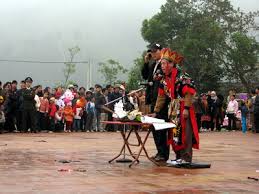Proper name: San Chay
Other names: Hon Ban, Chung, Trai.
Population: 114,012 people
Local groups: Cao Lan and San Chi
Language: The language of the Cao Lan belongs to the Tay-Nung group (of the Tai-Kadai language family) and the language of the San Chi belongs to the
Handicrafts groups (of the Sino-Tibetan language family).
History: The Sanchay migrated from China to Vietnam about 400 years ago.

San Chay Ethnic Group - Vietnamese Ethnic Groups
Production activities: The Sanchay are an agricultural people who farm mainly wet rice paddies, but they also cultivate swidden fields which they prepare by the slash-and-burn method. They use the digging stick to make holes for seedlings. Fish catching plays an important role in their economic life as well. With their unique fishing tools, such as hand nets and woven baskets, fish catching supplies the Sanchay food and improves their daily meals.
Diet: The Sanchay eat mainly ordinary rice. They also drink a lot of wine especially during the Tet holidays or Festivals. Men smoke tobacco in a water pipe. Women chew betel.
Clothing: Sanchay women wear the Cham-style skirt and long shirt or tunic which is decorated around the bottom hem and on the back. For daily wear, Sanchay women wear one Cham0style cloth belt, but on special occasions, like the Tet New Year festival, they wear two or three silk belts of different colors.
Housing: The Sanchay live in the provinces of the northeast. They live in the stilt houses of a style similar to those of the Tay, who live in the same area.
Transportation: The Sanchay usually carry goods on a bag on their back like a back pack.
Social organization: Before the August Revolution, land and fields were private property and social classes were more distinct. Landowners and rich peasants were part of Sanchay society. Depending on the area, the colonial government had some positions such as quan man, tai cha, quan lanh…In addition, there was an autonomous system of governance in the village, one that was voted by villagers and called khan thu. There are a variety of Sanchay lineages, with some of the largest family lineages being the Hoang, Tran, La, Ninh. Both the branches of the family lineages and worshiping cults play important roles in Sanchay community life.
Marriage: Before receiving the bride, the offerings and the Clothing of the reception group must be brought together and placed in the middle of the house in order to be blessed by the son of the ritual specialists. On the way to the groom’s house, the bride must walk without wearing shoes. After the marriage, the bride will stay in husband’s house. The matchmaker is respected by the bride and groom and is considered as the couple’s parents, and when the matchmaker dies the couple must take part in her funeral rituals.

Birth: Within 42 days after giving birth, strangers are forbidden to enter the house. During this time, if someone enters the house by accident and then a child gets sick, the stranger must bring offerings to worship the gods. Three day after giving birth, the Sanchay hold the ba mai ceremony (matchmaker ritual).
Funerals: Funerals will be led by Thay Tao (ritual specialist) and consist of many rituals which are affected deeply by Taoism and Buddhism. The Sanchay burial vault is built meticulously.
New House: The Sanchay pay much attention to choosing the land, the direction of the house, and the date and time to build a new house.
Beliefs: There are many altars in the typical Sanchay house. In addition to worshiping ancestors, they also worship heaven and earth, Tho Cong (Earth Spirit), Ba Mu (Goddess), Than Nong (Agricultural Spirit) and the cattle breeding spirit. The most popular cults worship Ngoc Hoang (Goa in Heaven), Nam Hoa Buddha), Tao Quan (Kitchen Spirit).
Tet holidays and Festivals: The Sanchay also have Tet holidays, similar to the Tay people.
Calendar: The Sanchay use the Han character in worshiping and in writing songs.
Artistic activities: In addition to telling old tales and reading poems, the Sanchay also like singing. The most popular Sanchay songs are the sing calendar, alternating love songs of young people. There are two kinds of sing calendar: those sung in the village at night and those sung on the way to or at the market. The Sanchay also sing for weddings and sing lullabies.
Entertainment: Badminton and top spinning are popular Sanchay games. At ceremonies and Festivals they play a game of standing on the head, called van rau cai.

 bởi
bởi 

